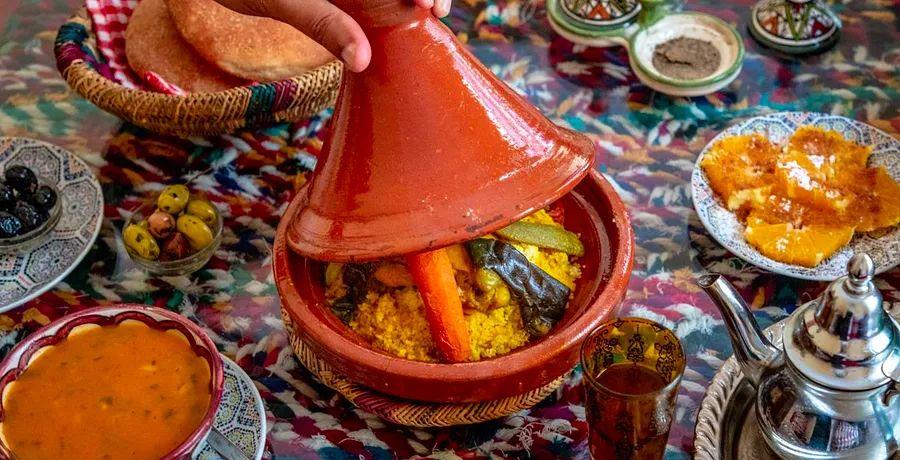You Absolutely Need a Tagine. Here’s How to Choose a Quality One.

It’s 2004, and I find myself seated at a large round table in my fiancé’s family home in Marrakech, Morocco. Despite my numerous offers to lend a hand in the kitchen being politely declined, I sit and wait for lunch by myself.
Suddenly, the table becomes adorned with an array of small plates, accompanied by warm, fluffy loaves of bread. Finally, my now-sister-in-law arrives with the highlight: a large clay tagine, which she places at the center of the spread. She lifts the cone-shaped lid, releasing a fragrant cloud of steam filled with aromatic spices into the midday air.
The bubbling stew continues to simmer as everyone tears off pieces of bread, eager to dip in. I dive straight for the tender lamb in the center, which falls apart as soon as the bread touches it. I scoop up a fried almond and some sauce before savoring the bite. My eyes flutter closed as I experience the delightful blend of sweet and savory. This marked the beginning of my love affair with the tagine.
Moroccan cuisine revolves around the tagine, a term that describes both the conical clay pot and the rich, slow-cooked stew it holds. This dish is a daily staple in many Moroccan households, where it’s enjoyed communally, with bread used to scoop up morsels of whatever the cook decides to include—meat, vegetables, nuts, and even fruits— all enveloped in a sauce bursting with freshly ground spices like smoky cumin and sweet paprika.
Though the internet offers numerous methods for mimicking a tagine using pressure cookers and slow cookers, nothing compares to the authentic experience of a slow-cooked tagine in its traditional pot. The clay not only adds its unique flavor but also absorbs the essence of the ingredients, while the conical lid is crafted to recirculate condensation back into the pot, ensuring that spices and herbs blend beautifully without losing any of that delectable flavor to the air. Plus, it’s not limited to classic Moroccan recipes; any tough cut of meat will thrive under the humid conditions of a tagine, making it an adaptable (and visually appealing) tool for any home chef.
For those visiting Morocco, picking up a tagine from one of the bustling open-air souks is almost mandatory, with prices ranging from 20 dirhams ($2) to 400 dirhams ($40). However, you can also find a quality tagine without needing to book a flight. Regardless, there are important considerations to keep in mind before adding another item to your collection (and already overflowing cabinets). Here’s some guidance on how to choose the perfect one for your needs.

Key Features to Consider
The fit: A tagine consists of two parts that should fit snugly together. To ensure a proper fit, open and close the lid a few times to check for any wobble or gaps along the edge.
Hole or no hole? Some tagines come with a debated opening either in the handle or lid. This feature is intended to release steam, which concentrates the cooking liquid inside. However, traditionalists argue that such openings defeat the purpose of a tagine. They claim that a hole can extend cooking times and cause dishes to dry out more quickly. Ultimately, it’s a matter of personal preference, but experts generally recommend opting for the classic, fully sealed style.
Lead Concerns: Although it's becoming less of a concern, there's still a possibility that tagines produced in Morocco could contain lead, which is something you definitely want to avoid. If you're unsure or if the seller doesn’t provide information on lead content, consider conducting a quick lead test with a portable home lead swab before cooking. Glazed tagines are typically the main offenders.
Size Matters: Tagines are available in various sizes, with the most common being individual (one or two servings), family-size (four to five servings), and large (six to eight servings). Choose the size that fits your typical needs; cramming too much into a small tagine can lead to uneven cooking and insufficient space for liquids, while an oversized tagine can crack more easily if the moisture isn’t monitored closely.
Functionality: It’s important to distinguish between cooking tagines and serving tagines, primarily regarding glaze and usability. In Moroccan markets, you'll find numerous beautifully painted tagines in vibrant colors—these are meant for serving and are not safe for cooking. For actual cooking, opt for a simple clay design that is free of paint and decorative elements.
The Different Styles
There are four primary types of cooking tagines: glazed, unglazed, aluminum, and cast iron. Each type offers its own advantages and disadvantages, depending on your specific cooking preferences.
Unglazed: Are you a tagine purist? An unglazed basic tagine is your best bet. However, it's one of the more challenging styles to work with. These tagines must be soaked in water and oiled before use, and they should only be placed over very low heat. It’s essential to monitor the liquid levels while cooking, as food can burn quickly in an unglazed pot. Despite the extra effort, the rewards are significant; the porous clay allows spices to infuse into the tagine itself. Each dish adds to that flavor, turning a well-loved tagine into a unique secret ingredient. Where to get it: Casablanca Market offers both unglazed and glazed traditional Moroccan tagines made in Morocco, shipped from their U.S. warehouse.
Glazed: The glaze on a tagine provides better resistance to burning but can also hinder the absorption of those delightful Moroccan flavors into the clay. Soaking a glazed tagine is still advisable to prevent cracking during heating. If you're new to using a clay tagine and want to play it safe, opting for a glazed version is a smart first purchase. Where to get it: Artisan potters Clay Coyote create a beautiful and functional tagine from their studio in Minnesota, shipping throughout the U.S.
Aluminum: Think of these as camping tagines. They're commonly used in Morocco by workers who need a portable lunch solution. Aluminum tagines are lightweight, easy to carry, and cook hotter than other types, but they’re not ideal for slow-cooking larger cuts of meat. Instead, use them for quick-cooking ingredients like fish or meatballs. Where to get it: You can find these online; in Morocco, they’re typically sold in shops that offer various kitchen goods or at local corner stores.
Cast Iron: A sturdy cast-iron tagine is perfect for novice cooks since it’s less prone to cracking or burning compared to clay options. They perform well over high heat and can even be placed in the oven if you run out of stovetop space. While cast iron is likely the most versatile and durable option, it tends to be the most expensive as well. Still, the investment may be worthwhile for a piece that lasts a lifetime. Where to get it: Le Creuset produces some of the finest cast-iron tagines available.

Amanda Ponzio-Mouttaki is a food and travel writer residing in Marrakech, Morocco, where she operates a culinary tourism company alongside her writing endeavors.

1

2

3

4

5
Evaluation :
5/5